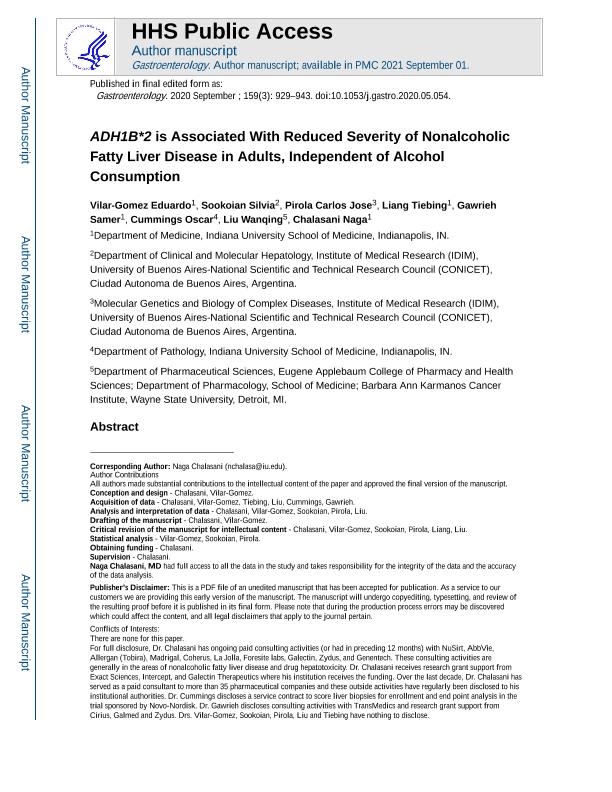Artículo
ADH1B∗2 Is Associated With Reduced Severity of Nonalcoholic Fatty Liver Disease in Adults, Independent of Alcohol Consumption
Vilar Gomez, Eduardo; Sookoian, Silvia Cristina ; Pirola, Carlos José
; Pirola, Carlos José ; Liang, Tiebing; Gawrieh, Samer; Cummings, Oscar; Liu, Wanqing; Chalasani, Naga P.
; Liang, Tiebing; Gawrieh, Samer; Cummings, Oscar; Liu, Wanqing; Chalasani, Naga P.
 ; Pirola, Carlos José
; Pirola, Carlos José ; Liang, Tiebing; Gawrieh, Samer; Cummings, Oscar; Liu, Wanqing; Chalasani, Naga P.
; Liang, Tiebing; Gawrieh, Samer; Cummings, Oscar; Liu, Wanqing; Chalasani, Naga P.
Fecha de publicación:
05/2020
Editorial:
W B Saunders Co-Elsevier Inc
Revista:
Gastroenterology
ISSN:
0016-5085
Idioma:
Inglés
Tipo de recurso:
Artículo publicado
Clasificación temática:
Resumen
Background & Aims: Alcohol dehydrogenase 1B (ADH1B) is involved in alcohol metabolism. The allele A (ADH1B∗2) of the rs1229984: A>G variant in ADH1B is associated with a higher alcohol metabolizing activity compared to the ancestral allele G (ADH1B∗1). Moderate alcohol consumption is associated with reduced severity of nonalcoholic fatty liver disease (NAFLD), based on histologic analysis, compared with no alcohol consumption. However, it is unclear whether ADH1B∗2 modifies the relationship between moderate alcohol consumption and severity of NAFLD. We examined the association between ADH1B∗2 and moderate alcohol consumption and histologic severity of NAFLD. Methods: We collected data from 1557 multiethnic adult patients with biopsy-proven NAFLD enrolled into 4 different studies conducted by the Nonalcoholic Steatohepatitis (NASH) Clinical Research Network. Histories of alcohol consumption were obtained from answers to standardized questionnaires. Liver biopsy samples were analyzed by histology and scored centrally according to the NASH Clinical Research Network criteria. We performed covariate adjusted logistic regressions to identify associations between histologic features of NAFLD severity and moderate alcohol consumption and/or ADH1B∗2. Results: A higher proportion of Asians/Pacific Islanders/Hawaiians carried the ADH1B∗2 allele (86%) than other racial groups (4%–13%). However, the study population comprised mostly non-Hispanic whites (1153 patients, 74%), so the primary analysis focused on this group. Among them, 433 were moderate drinkers and 90 were ADH1B∗2 carriers. After we adjusted for confounders, including alcohol consumption status, ADH1B∗2 was associated with lower frequency of steatohepatitis (odds ratio [OR], 0.52; P <.01) or fibrosis (odds ratio, 0.69; P =.050) compared with ADH1B∗1. Moderate alcohol consumption (g/d) reduced the severity of NAFLD in patients with ADH1B∗1 or ADH1B∗2. However, ADH1B∗2, compared to ADH1B∗1, was associated with a reduced risk of definite NASH (ADH1B∗2: OR, 0.80; P <.01 vs ADH1B∗1: OR, 0.96; P =.036) and a reduced risk of an NAFLD activity score of 4 or higher (ADH1B∗2: OR, 0.83; P =.012 vs ADH1B∗1: OR, 0.96; P =.048) (P <.01 for the difference in the effect of moderate alcohol consumption between alleles). The relationship between body mass index and NAFLD severity was significantly modified by ADH1B∗2, even after we controlled for alcohol consumption. Conclusions: ADH1B∗2 reduces the risk of NASH and fibrosis in adults with NAFLD regardless of alcohol consumption status. ADH1B∗2 might modify the association between high body mass index and NAFLD severity.
Palabras clave:
HISTOLOGY
,
OUTCOME
,
PROGRESSION
,
RISK FACTOR
Archivos asociados
Licencia
Identificadores
Colecciones
Articulos(IDIM)
Articulos de INST.DE INVEST.MEDICAS
Articulos de INST.DE INVEST.MEDICAS
Citación
Vilar Gomez, Eduardo; Sookoian, Silvia Cristina; Pirola, Carlos José; Liang, Tiebing; Gawrieh, Samer; et al.; ADH1B∗2 Is Associated With Reduced Severity of Nonalcoholic Fatty Liver Disease in Adults, Independent of Alcohol Consumption; W B Saunders Co-Elsevier Inc; Gastroenterology; 159; 3; 5-2020; 929-943
Compartir
Altmétricas



